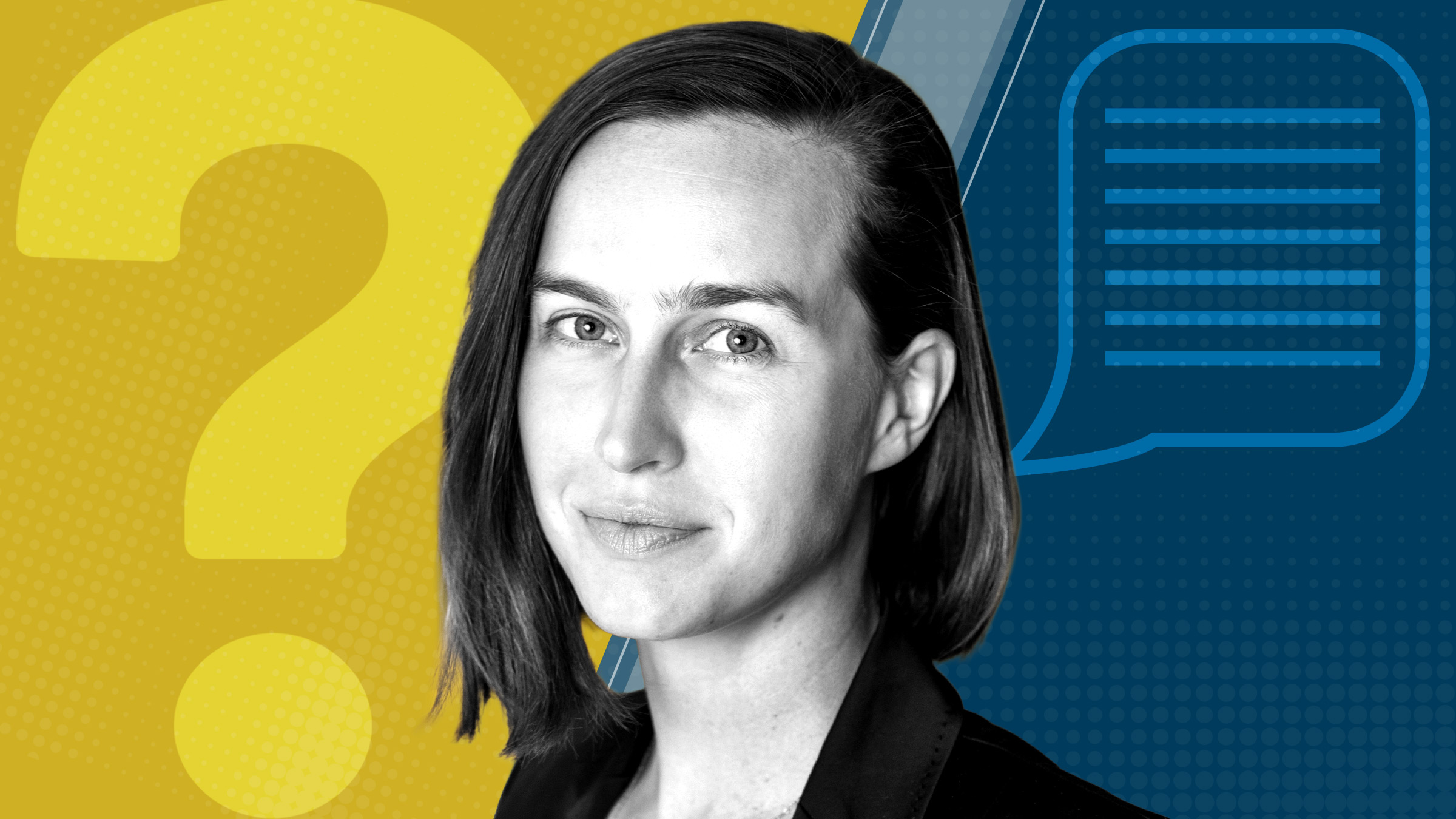
Marianne Bertrand’s research focuses on some of today’s most consequential and controversial issues: inequality, discrimination, sexism, CEO compensation and social divergence. And it uses her discipline’s most advanced methods, from machine learning and big data to randomized, controlled field experiments.
Her rigorous and inventive approaches to significant topics win acclaim from colleagues. She was honored with the 2004 Elaine Bennett Research Prize, given every two years to recognize “outstanding contributions by young women in the economics profession.” In 2012, the Society of Labor Economics (SOLE) awarded her the Sherwin Rosen Award, noting: “Her research is exemplary in terms of using rich and innovative data sets and estimation strategies to answer important questions.” That same year, she was inducted into the American Academy of Arts and Sciences and, in 2013, into the Econometric Society.
Bertrand’s research has brought her into the public eye as well, and influenced policy. Her paper on labor market discrimination, for example, “Are Emily and Greg More Employable than Lakisha and Jamal?” was widely reported in popular media as well as academe, and pushed companies and governments to reconsider how they screen job candidates. Her work on CEO pay showed that top executives were rewarded for “luck”—factors beyond CEO control—and that better board governance would align incentives toward better performance. The research helped shape stockholder and regulator efforts to overhaul executive compensation rules.
Bertrand’s work has “remarkable breadth,” noted the SOLE, and that scope is evident in four papers published in a single year, 2009: CEO trends (fewer internal hires and soaring pay); labor discrimination in Delhi (little caste or religion difference in call-back rates for new-sector job applicants); payday borrower use of tax rebates (infrequent borrowers pay down debt; regular users pay monthly bills); time use and eating (more calories when we watch TV).
Other work over the years has ranged from South African pensions to French business regulation, from an influential piece on statistical inference to the impact of market competition on wages.
The following discussion touches on yet other topics, including paychecks and gender norms among married couples, the glass ceiling that still excludes women from top jobs, and a phenomenon she calls “trickle-down consumption.” And it reveals an intellect as profound as it is wide-ranging.
Interview conducted March 22, 2018.
The glass ceiling
Region: I wanted to begin by asking about your forthcoming Economica paper, “The Glass Ceiling.” You’ve done a lot of work on the glass ceiling, of course, and this paper starts with the simple but disturbing observation that it persists—that despite significant progress, women remain underrepresented at the upper earnings levels, in top corporate jobs and on boards of directors.
Could you first share your thoughts on why, aside from basic human rights—
Bertrand: Why do economists care?
Region: Exactly. Why should we care, purely from an economic standpoint? It’s a case you make well in that paper.
Bertrand: Well, aside from simple human rights, as you say, I would ground the economic argument as to why we should care about this in the fact that women have now taken over men in terms of educational achievement. I would also ground it in the fact that if we believe that talent is equally allocated between men and women, then we must be leaving some money on the table in terms of productivity and economic growth by not having more women leading corporations.
In my work, I focus a lot on the corporate sector. A colleague has written a paper that seeks to quantify how much of the growth in GDP over the last 40 years can be explained by the growing representation of women and minorities in occupations where they previously tended to be underrepresented because of various barriers to entry. The paper estimates that a quarter of GDP growth over that time period could be related to lowering barriers of entry to women and minorities in professions where they’d been previously underrepresented.
So that’s the argument that I would push as an economist as to why we should care. If talent is indeed equally represented between men and women, if there are as many women as men going into business education, it doesn’t seem that we have the right allocation of talent by having essentially 95 percent of Fortune 500 companies being led by men.
Region: You review three potential explanations for the persistence of the phenomenon. First is the fact that although women have surpassed men in general educational attainment, they don’t have equal levels in some higher-earnings fields such as business. Second is possible psychological differences between men and women that you conjecture might explain 10 percent of the gap. And third is that there remain differential demands on women versus men for nonmarket time—child care, home chores and the like.
Given what you know from that evidence reviewed in the paper, what are possible policies and practices that could address the gap?
Bertrand: It’s a tricky question. Let me start from the three explanations that you just discussed. The first one is about education. While, as I said before, women have surpassed men in terms of education, it is still true that women seem to shy away from the kind of educational majors that tend to be entry points into higher-earnings occupations. Convergence has been happening, but there is still a bit of a gap. I think it’s a less important explanation, but it’s still a fact worth mentioning.

With respect to the second explanation, psychological differences, while it has been a very active area of research, my reading of the literature is that it is not quantitatively very important in explaining the glass ceiling. If that is the lead explanation, it’s not very clear what could be done in terms of policy. It really depends on whether you think these psychological traits are something we’re born with or whether they’re something that we are kind of nurtured into.
If you don’t think that we are born with such traits, it’s a bit easier to think about policy implications. If it’s about the way we teach our girls to be risk averse—how we tell them competition is not so important for them, in contrast to what we tell our boys—then I think the policy implication is really in the educational area. The way we raise boys and girls should converge more than it has so far. But, again, this is all speculative because of the nature-versus-nurture point I discussed before.
The policy implications are, again, not obvious with respect to the explanation that I think is the most important one: that higher-paying occupations are more inflexible and require more time commitment, and that women have a harder time with this inflexibility because they remain disproportionately responsible for everything to do with the home, including raising children.
How can policy address this? Certainly, there’s overlap with what I said before in relation to education. As parents, the way we raise our boys and girls should be less gendered, not reinforcing the stereotypes that girls belong in the home and boys belong in the workforce.
The other policy that I feel is potentially important in this regard is efforts to move away from maternity leave and toward parental leave and paternity leave. There are examples from Scandinavian countries that have gone in that direction, which is, again, about trying to break the association between women and home activities. Any policy that would speed up those changes would be a right one.
Region: You looked at Norway’s legislated quotas for women on corporate boards in another paper and found mixed results: While the legislation benefited the women appointed to those boards, it had no clear impact on other women, including young women, who didn’t increase their enrollment in business education programs post-reform.
Bertrand: Yes. Quotas have been the main policy response in Europe, and we studied the Norwegian reform because that was the first of its kind. If you think about how quotas may help in breaking the glass ceiling, the main argument has to do with breaking the “old boys network,” and that women will empower other women. But as you think through these potential mechanisms, none of them have, I think, anything to do with the core explanation that I stressed before, which is women having a more difficult time balancing home responsibilities and work responsibilities. So from that perspective, it’s not so surprising that the quotas are not that effective.
Gender, relative income, family, life satisfaction
Region: You bring that home, almost literally, in another paper, with Emir Kamenica and Jessica Pan, in which you look at the causes and consequences of relative income within households. The study got a lot of attention when it came out, possibly because it confirmed what many suspected.
Could you review some of its key findings? Also, if you would, please elaborate on the reaction of some women who, as you put it, “are bringing their personal glass ceilings from home to the workplace.”
Bertrand: The idea of the paper was to focus on the particular gender identity norm, which is the idea that men should earn more than their wives. It’s an interesting one to focus on because it’s a norm that may only have become binding today. It may not have been that relevant in the past because women were much less likely to have the potential to out-earn their husbands, and now they do.
So the idea of the paper was to investigate the empirical relevance of this norm among households as well as its implications.
Region: This figure from the paper is astonishing. [See Figure I, p. 39.] It shows the husband/wife earnings distribution for U.S. households and documents the sharp drop-off in percentage of households where the wife earns more.
Bertrand: Yes, this figure is pretty cool. This was item number one in the paper. Let’s do something very simple: Look at the distribution of relative income of wife and husband within couples. If this norm is important, we should see, quote-unquote, “too few” couples where the wife earns more than her husband. And this is exactly what we found in administrative data; that’s the picture that we’re looking at right there.
And then, in a sense, starting from this picture, we tried to figure out where this could be coming from. One possibility is that those “missing” couples where the wife earns more than her husband may never get formed, meaning that it’s something about the marriage market. So one section of the paper looks at the distribution of earnings of men and women in various marriage markets—say, for example, white people in the Chicago area. And we show that the marriage rate in a particular marriage market was lower if the likelihood that a woman bumping into a guy at random and her earning more than him was high.
Another reason why this picture may exist is that those, quote-unquote, “missing” couples were less stable. So they existed, but they were more likely to break down. And we also found evidence of that in the data. Looking at couples where the wives earn more than the husbands, we found signs of more marital instability, more marital unhappiness and some signs that these couples were more likely to end up in divorce.

Another finding in the paper is related to work that [University of California, Berkeley economist] George Akerlof did in 2000. We found that in those couples where the wife earned more than the husband, there’s evidence of compensating behavior by the wife. Holding everything else constant, we found that potentially important in this regard is efforts to move away from maternity leave and toward parental leave and paternity leave. There are examples from Scandinavian countries that have gone in that direction, which is, again, about trying to break the association between women and home activities. Any policy that would speed up those changes would be a right one.
These were the three main findings of the paper.
Region: Were there any optimistic trends? I know you look at a recent cohort, those born since ’65 and—
Bertrand: Yes, well, this picture is based on administrative data, which date back from the 1990s. In the census data, we found some evidence that the sharp drop-off was decreasing over time.
Trickle-down consumption
Region: Thorstein Veblen coined the term “conspicuous consumption” over a century ago. With Adair Morse, you document its current manifestation in “trickle-down consumption,” in which nonrich households spend more of their income on consumption goods and services when they’re exposed to the income levels and consumption patterns of rich households.
And after eliminating several plausible noncausal explanations for this relationship—the permanent income effect, wealth effects, higher local prices—you find evidence consistent with “status maintaining.”
Could you tell us about this research, starting with the motivation for this study—what led you to look into the spending/saving decisions of nonrich households?
Bertrand: We have all this important research on the growth of income inequality over time. We also have a rich literature giving us the key explanations behind this rise in income inequality, from globalization forces to skill-biased technological change.
But as economists, we have much less to say about the consequences of the rise in income inequality, and that’s a topic of great interest to me. Some people would say we don’t need to document consequences, that for ethical reasons, it’s enough to know that income inequality is growing, but I feel it’s important to talk about the implications of growing inequality.
This paper is really just a first foray into one angle. We’re certainly not the first to talk about this. I think the person who has talked the most about the kind of dynamics that we try to highlight in the paper is Bob Frank. If people are concerned about their status compared to others, when they get exposed to people with higher income and consumption, they may try to maintain their status, and this may mean spending a greater share of income and saving less.
Region: Why do you find “status maintaining” the most plausible explanation after looking at other correlates?
Bertrand: Well, as you say, we looked at some of the other correlates that come with being, say, a middle-income person, exposed to more rich people. For instance, you may spend more because you’re exposed more to the stores that rich people buy at. The reason we zoom in on status maintaining as the explanation is that we examine the goods that people spend a disproportionate amount of their money on when top incomes rise around them, and we see that they’re the kind of goods that are more “visible,” more conspicuous in nature.
Region: You also talk about the political economy of this—the expansion of credit that might have aided this trend.
Bertrand: Yes. It taps into some of the arguments that my colleague Ragu Rajan made in his book Fault Lines. So we focused on a particular piece of legislation that Ragu identified as being very important in terms of expansion of credit. If you believe the “status-maintaining” dynamics that we talk about in our paper, you may hypothesize that particularly in those congressional districts where income inequality was greatest, the congressmen saw the greatest pressure from median voters to expand credit since those median voters are trying to maintain their status compared to the top of the income distribution that is close to them.
And, indeed, we found that the likelihood of voting in favor of this expansion of credit was greater in those congressional districts where income inequality—particularly the gap between the 50th and the 90th percentile—was greatest. It’s really just meant to be suggestive, a final section in the paper motivating others to do more work on this, but we thought it tied everything together well.
Coming apart?
Region: That leads me to another piece of your research. I’m not sure if it’s a paper yet, but I saw a video of a presentation you delivered on “Coming Apart?”
Bertrand: That’s what I’m writing right now. You saw the MIT presentation?
Region: Yes, that was it. You looked at 40-year trends in attitudes, consumption and behavior by the rich and not-so-rich. And it’s within the context of this huge economic divergence we’ve talked about, inequality greater than it’s been since the Gilded Age. There’s also a sense that we’ve grown apart culturally and politically and that this division may self-perpetuate to the degree that it impedes social mobility.
Could you give us the broad outlines of this study—your motivation, the techniques and, especially, the findings?
Bertrand: The presentation that you saw was still based on preliminary work. The paper has evolved since then. We are applying the methodology to groups other than income. Besides income, we are now also studying time trends in cultural distance by education, gender, race, urbanicity and political ideology. But I’ll focus on income for now.
The motivation for this work was very much the same as what I said before about the trickle-down consumption paper, which is thinking about the consequences of income inequality. The idea for this paper actually came out of a lunch conversation we had in this room [a seminar room at the University of Chicago’s Booth School of Business]. We were talking about income inequality, and one of our colleagues said, basically, “Well, at the end of the day, who cares? Yes, maybe we’re growing apart economically, but on Sunday all we all do is watch TV. We are growing apart economically, but our lives may not be that different; they may, in fact, have converged.”
So, this is kind of an interesting point. How much can we say about how the lives of the rich and the poor changed? Let’s try to put together all of the data sets that we can think of over the longest time period that we can and say something about what it’s like to be rich, which we define as the top quartile of the income distribution, versus poor, which we define as the bottom quartile. What was it like several decades ago? What is it like today?
Another key motivation for this is this idea that culture is important, the way we live is important. I like to use the example you mentioned, social mobility. Suppose we work at the same company. You are my boss. I’m your employee. You’re from the top of the income distribution, and I’m from the bottom. My ability to move up in the company might be a function of how much you connect with me, and connecting with one another might be a function of the quality of the conversation that we can have around the water cooler. Did we do the same thing over the weekend? Do we watch the same shows? Do we have the same hobbies and eat the same food?
So we tried to assemble all the data sets we could; for example, time-use data, which go back to the 1960s. Another data set that a lot of social scientists use is the General Social Survey, which tells us something about views and opinions—views on abortion, gays, racial issues, government spending and the like.
Region: And you also found data on marketing.
Bertrand: Yes, we had access to a marketing data set, which is truly remarkable. In that data set, we can see media consumption—what TV shows people watch, what movies they watch, what magazines they read. The data set also shows thousands of products that people may or may not buy, and thousands of brands that people may or may not buy or own.
Then we built a metric of cultural distance between groups by income. There are many ways you could measure distance. We use a machine-learning algorithm and aggregate a number of methods that allow us to find the best model to predict someone’s income based on the brands or products they report consuming or the attitudes the person has.
Region: And you look at the trends in your ability to predict—essentially asking, Is our ability to predict a person’s income based on the products they buy or beliefs they hold improving, getting worse or not changing?
Bertrand: Yes, we look at the trends in that over time.
The main headline result of the paper is that most of the trend lines are flat. Our ability to predict someone’s income based on the consumption of particular goods and brands is essentially the same today as it was 25 years ago. There’s no trend in our ability to predict people’s income based on how they spend their time today, compared to close to 50 years ago. The only area where we see some slight evidence of divergence on income is with respect to social attitudes, where our ability to predict people’s income based on what they think, their views, is slightly better today than it was in the early 1970s.
Region: But even that is just slight?
Bertrand: Right. It’s a slight improvement. What’s new that you haven’t seen is now we’ve done this exercise, as I said, for race, gender and urbanicity. When we first got these results on income, people said, especially in the context of the recent election, “Well, income is not the important one; it’s urban/rural. That’s the important divide in America.” We’ve also done it based on political attitudes, and the main result, which I just gave you for income—there’s no big trend—essentially applies to, at a first-level of approximation, everything that we have looked at.
The one really large exception quantitatively is our ability to predict whether someone is liberal or conservative/Democrat or Republican based on their social attitudes. That has been increasing over time. So liberals and conservatives haven’t been diverging over time on TV consumption, brands or goods, but on social views they have been diverging a lot over time.
The results were surprising to us. We went into this with in the back of our mind the discussion that’s happening right now [that Americans are increasingly divided along economic and other lines], and we really thought that we were going to see signs of that in the data.

How do I rationalize the results? It’s not clear, but here’s one thought when it comes to products and brands. I think today we think you can easily see who is rich or poor because rich people own an iPhone and poor people don’t; but, then, 25 years ago, it was whether you owned a DVD player that separated rich and poor. There are waves of technological changes—the rich, the more educated are always going to be the early adopters of those—but there are constant waves of technological change.
Region: Where do you think you’ll take this research from here? In the presentation I saw, you said you might let machine learning take over in terms of following the direction set by the data. Have you been able to do that?
Bertrand: No, not yet. That’s going to be the next paper. We’re trying to finish writing this one this month and then the next paper is, indeed, going to do some unsupervised machine learning and let the data speak about whether, based on their responses, we see clusters of individuals who are separating themselves from each other, and what are the main characteristics of these clusters in 1970 compared to today. So this is letting the data speak with respect to what particular characteristics, and combinations of characteristics, people are segmenting themselves on over time.
Discrimination
Region: You’ve done important and influential work on discrimination in the United States, India and other countries. One prominent example is the 2004 study on discrimination in labor markets between “white” and “black” names. Another is your 2012 study showing variation among judges in black-white discrimination on some dimensions but not others—incarceration rates, not sentence length.
More recently, with Esther Duflo, you provided a careful survey of field experiments in discrimination, noting that they’ve been successful in documenting it, but that you’d like to see future field experiments aim at “isolating effective methods to combat it.”
Could you elaborate on that? What would such experiments look like? Are any being done, to your knowledge, at J-PAL or elsewhere?
Bertrand: Yes, well, that’s interesting. I’m actually starting some work on that.
What you said is exactly right. I think we’ve been very good at measuring discrimination, using field experiments to do that, as in that paper that we did 14 years ago and lots of follow-up work since.
What Esther and I highlighted in the survey piece is that there are important ideas, especially coming out of the psychology literature, about ways to fight bias—trying to teach people to be less biased, for example, and using technological debiasing. But while such things might reduce bias and may have demonstrated impacts in the lab, there is very limited evidence on whether they work in practice in a real-world setting.
So, to give one particular example, I’m currently talking to a company whose CEO was previously part of the Nudge Unit in the U.K. And they are proposing alternative ways to do résumé screening.
Think about that research we did in in 2004, where the human resources manager has a pile of résumés. I think what’s behind our result is that if you’re an HR manager under time pressure and have a pile of résumés, well, you see a name on top of the résumé like Lakisha Washington, you dismiss it and move on. So are there ways to avoid this particular bias? I don’t assume this HR manager is racist, but he or she is under time pressure and makes an implicit association between a name and a background.
This company’s idea is to do multiple things that psychologists tell us should be useful to undo such bias. The first one is anonymizing résumés, taking the name out of the equation. Another feature that psychologists suggest would be important in driving mistakes by the HR manager is what’s called contrast effects. Suppose an applicant submits a résumé; the worst thing that could happen to this applicant is to have her résumé in the pile right behind someone who’s stellar, because the HR just saw a stellar person and, in contrast to that, you don’t look great. So they have ways to take out these contrast effects by reshuffling the order in which things are reviewed by the HR managers.
Another thing psychologists tell us is important is to rely on the wisdom of the crowd, so not having just one person reviewing résumés, but having multiple people review. Finally, another thing that is important to avoid bias is forcing whoever is making the decision not to just say, “I don’t like this person,” but to explain why they don’t, to write a paragraph explaining why this applicant is not qualified.
These are the main components this company has put together, and right now we’re trying to find companies that are looking to hire and are interested in seeing how well they can do in their recruiting by using a tool like this one—which I would say falls into the category of technological debiasing—compared to the standard approach to recruiting, which is more the HR manager going over a pile of résumés.
The idea is that using this alternative recruiting model should have two outcomes. One is a more diverse set of employees, but the other is a better set of employees because the company didn’t fall for biases in their recruiting practices.
So we’re looking for a company that would be interested in doing this, both so that we can document what impact it has on diversity of the recruited candidates and to tie that back to metrics of performance for the recruited candidates and assess, Was it good for the company from a bottom-line perspective?
Region: Makes me think about discrimination in college admissions too.
Bertrand: Absolutely.
The trouble with boys
Region: Your “The Trouble with Boys” paper with Jessica Pan is a real revelation. To my knowledge, it’s one of the first methodical explorations of potential social/environmental sources of noncognitive differences between boys and girls. As you point out, the differences have been well documented, and your study—which follows a large sample of kids from kindergarten through 8th grade—provides further confirmation.
Can you talk about the apparent sources of the gap? You observe that there may, of course, be biological sources, but your focus is on social influences; in part, because there’s room for intervention if they play a part.
What did you find, and what does it signify for potential future trends in U.S. inequality?
Bertrand: The New York Times just ran a piece on this new paper by Raj Chetty and colleagues on inequality by race and the trouble that black boys especially have. I think there are some interesting linkages to our work.
The main thing that we stress in this paper is that the gender gap in noncognitive skills is particularly large in broken families. And that term can mean many different things. It’s low income, it’s absent fathers, it’s less education, it’s fewer parental inputs.
Toward the end of the paper, we discuss future implications and the potential of a vicious cycle. If you have boys doing more poorly in broken families, that means that a lot of these boys become less marriageable. That means more single moms and more broken families in the future and hence, again, more boys growing up in conditions where they may not get the kind of parenting that could address whatever deficiencies they have in noncognitive skills.
Region: And why do broken families affect boys more than girls?
Bertrand: I don’t feel like I can definitively answer this question. It’s much more speculative. One argument we make in the paper is that boys may be born at greater risk of having noncognitive problems than girls.
Region: A biological difference.
Bertrand: Yes. And if that’s true, then it’s particularly important to have stronger parenting for boys than girls in order to correct this deficit. But, again, that’s highly speculative.





